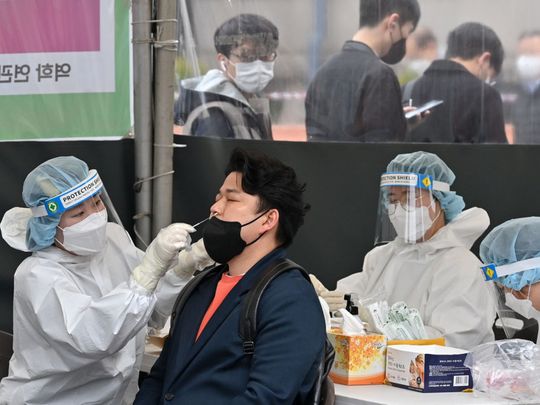
SEOUL: South Korea has reached two seemingly contradictory pandemic milestones: It recorded more than 600,000 new COVID-19 infections on Thursday, the most of anywhere in the world. At the same time, the country has one of the lowest virus death rates globally.
While anywhere else an infection surge of this size would signal an out-of-control outbreak soon to be followed by a spike in fatalities, in South Korea - which is about the size of Indiana in the US - the picture is more complex.
The sky-high caseload reflects the nation’s consistent deployment of mass testing, largely abandoned by many places as COVID-19 becomes endemic but a key reason behind Korea’s sliding death rate, according to its virus fighters.
Continuing to officially diagnose most infections allows Korea to identify at-risk cases and preemptively treat or hospitalise those patients before their conditions become severe.
Combined with an 88% vaccination rate - and one of the highest booster shot take-ups in the world, especially among the elderly - it’s delivered a fatality rate of 0.14%. That’s one-10th of the rates in the US and the UK and down from 0.88% two months ago, even as cases have surged eighty-fold in the same time frame.
The unorthodox approach is typical of Korea’s response to the pandemic, which has been prescient from the beginning. The country pioneered the use of quick testing and high-tech contact tracing early on, using lessons learned from previous epidemics. While it’s seen more than 8 million cases since the start of 2020, Korea has never locked down and managed to overcome a slow start to vaccination by looking beyond those first shots to prioritize supplies of boosters, which have been targeted at the elderly.
The focus on testing has been expensive. The nation has spent about $1.3 billion on PCR testing so far, the Korea Disease Control & Prevention Agency said and now has the capacity to conduct a million PCR tests a day.
But the payoff is immeasurable, government officials say, as hospitals haven’t been overwhelmed and the health care system is still intact.
Despite daily cases spiking to 621,328 on Thursday - from less than 9,000 before emergence of the micron variant in late January - hospitalisations have only doubled, with intensive care unit capacity at 65%.
“Another critical point in preventing deaths is the ICU capacity and Korean hospitals generally have a good handle on the situation,” said Choi Jae-wook, professor of preventive medicine at Korea University College of Medicine.
Now, despite the world-leading caseload, the falling fatality rate has the government considering further easing of pandemic restrictions, including lifting a six-person limit on private gatherings and extending restaurant hours.
Refining strategy
South Korea’s health officials say they’ve been better prepared to deal with the ebb and flow of the coronavirus pandemic partly because of lessons learned during its botched handling of a Middle East Respiratory Syndrome outbreak in 2015. Among key lessons, stay nimble and respond quickly.
As Omicron took hold in late January, rather than being overwhelmed, Korea doubled down on testing. Like many countries, the testing strategy was expanded to include rapid antigen tests. But unlike elsewhere, those who test positive at home still have to go to a government-run PCR testing center for confirmation.
From there, positive cases who are asymptomatic or have mild symptoms are required to quarantine at home, while those deemed at high-risk of serious illness are sent to hospitals for care and treatment.
“It is more ideal to use PCR tests with high accuracy in as many places as we can, yet the adoption of the rapid antigen test is a measure to protect the high-risk group that has a greater risk of getting severely ill,” the KDCA said in a statement.
Vaccinating the elderly
At the same time, Korea stepped up its vaccine rollout after initially lagging behind, focusing particular attention on getting elderly and high-risk individuals inoculated. Nearly 86% of the population had been fully vaccinated when Omicron started to spread, with more than 90% of those aged 60 and above also boosted.
“The mortality rate is close to zero among those 60 and under who have completed the third vaccination,” Park Hyang, the health ministry’s anti-epidemic prevention and response management department director general, said at a briefing this week.
Most of the deaths have been among the small group of elderly who haven’t been vaccinated. Those 60 years and older who weren’t inoculated are ten times more likely to die than those who have had boosters, she said.
But despite the falling death rate, Choi at the Korea University College of Medicine warned against lifting social-distancing and other pandemic curbs too soon.
Other countries, including the US and UK, are abandoning restrictions as populations become more comfortable living alongside COVID, even as their caseloads and deaths pick up again.
“Easing virus-prevention measures now will inevitably lead to more deaths and critical cases, and the government shouldn’t be the one judging that this is OK yet just because there is enough ICU beds,” Choi said. “They should notify and pass along precautions in advance to the public.”












